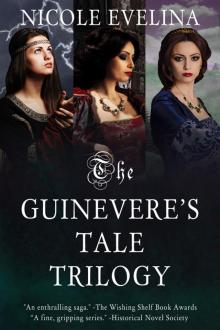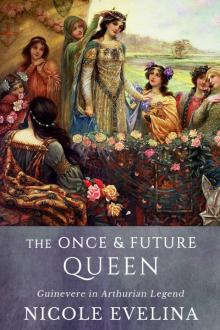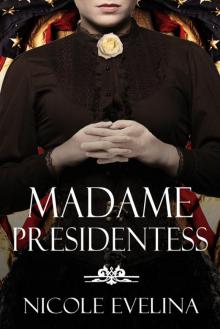- Home
- Nicole Evelina
The Once and Future Queen Page 2
The Once and Future Queen Read online
Page 2
Chapter Three covers the beginning of the Middle Ages, with The Life of Gildas and Geoffrey of Monmouth as the early determiners of her character. This section begins with a discussion of how women were treated during this period and how prevailing thoughts and attitudes might have influenced Guinevere. There follows a discussion of how Guinevere’s kidnapping by Melwas, which Gildas introduced, could be connected to the story of the rape of the Flower Bride in Celtic myth. Next, we see how Geoffrey of Monmouth establishes the passive Guinevere, beginning a centuries-long tradition of her being regarded as little more than a royal beauty whose lust was Camelot’s undoing.
Chapter Four takes us deeper into the Middle Ages where Wace and Layamon rewrite Geoffrey to give us more of the story we recognize today. We’ll uncover the origins of Guinevere’s personality, including her much-touted feelings of guilt over her affair, and see how Layamon’s changes take her from a conflicted woman to a villainous whore, a reputation she will struggle to overcome.
Chapter Five focuses on the monumental contributions of the French to Arthurian legend, especially Chrétien de Troyes’ many unique introductions to the story and Marie de France’s odd representation of a truly evil Guinevere. This chapter also features a discussion of courtly love and how it may have influenced how Chrétien approached the legend and its characters.
Chapter Six delves into the role of the Cistercian monks in changing the course of the legend in the Vulgate Cycle, including through the stories of the True and False Guineveres and by adding a distinctly religious element to Guinevere’s sin, forever linking her to Biblical figures such as Eve and Mary Magdalene.
Chapter Seven marks the high point of the Middle Ages and the part of the legend that is the most well-known today. But before turning to what is familiar, we explore the lesser-known Alliterative Morte Arthure (1400), which depicts a very negative Guinevere. We then turn to Thomas Malory with his “Poisoned Apple” and the famous Morte d’Arthur (1485). By examining the contradictions inherent in Malory’s Guinevere, we see the polarities of the character in sharp relief and experience her becoming the guardian of morality, a role she’ll continue to hold for the next four centuries.
Chapter Eight provides a brief overview of the disinterest in the Arthurian legend from the Renaissance to the nineteenth century. It also briefly explores how changing morals and the shift of religious sentiment from Catholic to Protestant resulted in a dearth of Arthurian material for approximately two hundred years.
In Chapter Nine, we visit the Victorian era and the resurgence of interest in the Arthurian legend. Here we’ll look at how Victorian morality influenced Tennyson’s famous Idylls of the King (1869) and how Guinevere reflected this society’s simultaneous abhorrence of and fascination with the figure of the fallen woman.
Chapter Ten looks at William Morris’ controversial poem “In Defence of Guenevere,” which, despite its title, may not be any defense at all. Or conversely, it may be a cry for independence from a woman written for a highly constrained Victorian audience—we’ll examine both viewpoints.
Chapter Eleven moves us into the twentieth century with a discussion of society’s unrelenting fascination with the Arthurian legend, which is reflected in the sheer number of Arthurian novels and short stories published during this century. Following is a discussion of T. H. White’s famous The Once and Future King (1958) and how he appears to have transferred his issues with women onto the female characters he wrote, including poor Guinevere, who took on many of his mother’s negative qualities.
Chapter Twelve begins with a look at how the changes in women’s rights, including the rise of feminism and women’s studies programs in colleges, affected the way Arthurian legend was viewed from the period of 1960-1980. Next is a discussion of two rather un-feminist portrayals of Guinevere in Rosemary Sutcliffe and Mary Stewart’s famous Arthurian books.
In Chapter Thirteen, we look at one of the most famous modern Arthurian novels, Marion Zimmer Bradley’s The Mists of Avalon (1983). Core to this chapter is a discussion of why, for all of the novel’s feministic triumphs with Morgaine and other female characters, Guinevere is still a weak woman, very much at the mercy of the men in her world. To answer this question, we must examine the motivations Bradley gives Guinevere and statements she is trying to make about the patriarchy.
Chapter Fourteen brings us to two authors who bridge the gap between the patriarchal versions of Guinevere to date and the ultra-feministic ones to come. This chapter examines how in the early-to-mid-1980s, Parke Godwin gave us the first Guinevere who showed agency, intelligence, and a willingness to be Arthur’s equal. We also explore the Guinevere of Gillian Bradshaw’s In Winter’s Shadow (1982), another highly active and independent woman, but in ways markedly different from the one Godwin created.
Chapter Fifteen opens with an examination of how the second wave of feminism—and its attendant stressors on women to be simultaneously perfect wives, perfect mothers, and perfect career women—pushed women into the (sometimes mistaken) belief that they could do it all. This is followed by an analysis of Sharan Newman’s Guinevere trilogy, which shaped the future of the legend by being the first to explore Guinevere’s early life.
Chapter Sixteen is devoted to the writings of Persia Woolley, who takes Guinevere back to her pagan Celtic roots and purposefully shows her as Arthur’s equal. As the chapter will show, the changes she makes to the legend appear to correspond with events and concerns of the late 1980s and early 1990s.
Similarly, Chapter Seventeen looks at two additional female writers focused on Guinevere with two very different takes on the famous queen. A discussion of Nancy McKenzie’s works shows us a bratty, immature queen who is cowed by her cousin, Elaine, while Rosalind Miles’ Guinevere is decisive and bold—just don’t call her a feminist construction.
Chapter Eighteen begins with an analysis of why fictional portrayals of Guinevere seemed to drop off the radar of traditional publishing after the year 2000 and how independent authors took up Guinevere’s cause in their novels. What follows is an analysis of the Guineverian writings of one such indie author: Lavinia Collins. Utilizing reader reviews left on Amazon and Goodreads, we see a Guinevere who is very much written for the new millennium, a strong woman who is not afraid to own her sexuality or take what she wants.
Finally, Chapter Nineteen is where I explain my own Guinevere novels in the context of their time and society. They are too new to know what their cultural impact will be through the eyes of critics, so included is an explanation of why my Guinevere is written as she is and what I hoped to achieve by telling my specific version of her story.
A Note on Names
Guinevere’s name has changed with the location of the author and the time period in which her story is written. The Arthurian Material in the Chronicles lists twenty-one variations of her name.6 Some of these include: Gwehywfar (Welsh), Guanhumara/Guenhumara (Geoffrey of Monmouth in Latin),7 Wenneuereia (Gerad of Wales), Gwynnever (Middle English), Guinevere (French), Guenever (T. H. White), Ginevra/Givevara/Ginover (German), Wehaver/Wenhaver (Layamon), Winlogee (Breton),8 Gaynore/Waynor (The Alliterative Morte Arthure), and Gwinfreda (a Saxon in John Gloag’s 1976 novel Artorius Rex).
The meaning of Guinevere’s name is variously translated as “the white phantom or fairy,”9 “the white or fair enchantress,”10 “the white fay or ghost,” or the “white shoulders.” Her name’s etymology derives from “white, fair, or holy” and “magical being,”11 which is both interesting and unexpected because in most traditional Arthurian legend, it is Morgan who is associated with magic and the Otherworld rather than Guinevere.
For ease of reading, in this book the name of Arthur’s queen will be spelled Guinevere unless another spelling is used in a direct quote, as this spelling is the one most commonly known by modern readers. Likewise, I will use these spellings for the other main Arthurian characters: Arthur, Lancelot, Morgan, and Merlin.
>
* * *
1 Cooley, Sara Diane, “Re-vision from the Mists: The Development of a Literary Genre of Feminist Arthuriana as an Allegorical Response to Second Wave Feminist Politics” (Senior Capstone Projects, Paper 520, Vassar College, 2015), 11.
2 Ibid., 12.
3 Comer, Stephanie, “Behold Thy Doom is Mine: The Evolution of Guinevere in the Works of Chrétien de Troyes, Sir Thomas Malory, and Alfred, Lord Tennyson” Master's, Eastern Michigan University, 2008), iv.
4 Comer, "Behold Thy Doom," 75.
5 Gordon-Wise, Barbara, The Reclamation of a Queen: Guinevere in Modern Fantasy (New York: Greenwood Press, 1991).
6 Fletcher, Robert Huntington, “The Arthurian Material in the Chronicles Especially Those of Great Britain and France,” in Studies and Notes in Philology and Literature, Vol. X (Boston: Ginn and Company, 1906), 298.
7 Bromwich, Rachel, “Celtic Elements in Arthurian Romance: A General Survey,” in The Legend of Arthur in the Middle Ages: Studies presented to A.H. Diverres by Colleagues, Pupils, and Friends, ed. P. B. Grout et al. (Cambridge: D.S. Brewer; Torowa N.J., U.S.A.: Biblio Distribution Services, 1983), 42. Bromwich notes that Geoffrey must have “derived [this name] from a written source in Old Welsh.”
8 Matthews, John and Caitlin, The Complete King Arthur: Many Faces, One Hero (Rochester, Vermont: Inner Traditions, 2017), 175. The name comes from an image in the Modena Cathedral in Italy.
9 Ibid., 175.
10 Bromwich, Rachel, “Celtic Elements in Arthurian Romance,” 42.
11 “Guinevere,” Wikipedia, accessed January 23, 2017, https://en.wikipedia.org/wiki/Guinevere
CHAPTER ONE
An Overview of the Character
Literary Identity vs. Historical Fact
Before we delve deep into history, it will be helpful to have a refresher of what the Arthurian tradition tells us about Guinevere. In relation to other characters such as Arthur, Lancelot, and Merlin, we know precious little about Guinevere. Nevertheless, there are some constants. Nearly all versions of the story agree on these facts:
She was the wife of Arthur and the queen of Camelot.
At some point, she takes a lover in an adulterous affair. Sometimes he is Mordred or Bedivere, but most commonly after the twelfth century, he is Lancelot.
One or more times during the story, she is kidnapped by Malegant/Mordred/Melwas/Kay, depending on the tradition. Sometimes she suffers rape and/or abuse at his hands. Most of the time her rescuer is Lancelot, but in a few versions, it is Arthur. This element is believed to have its basis in “a Celtic narrative in which a fairy leaves her otherworldly mate to become the wife of a mortal only to be reclaimed later by her original partner.”12
For her crimes, which vary from adultery and treason to witchcraft, she is sentenced to burn at the stake.
Lancelot rescues her. Oftentimes, Arthur follows the couple, leaving Mordred free to take over Camelot. The ensuing power struggle leads to the battle of Camlann, where both men are killed.
Like the rest of the Arthurian legend, scholars believe most of this is the fantasy of literature, rather than historical fact. Historically, we know that someone did gather the British tribes in a coordinated defense against and defeat of the invading Saxons sometime between 490 and 530 CE that resulted in a period of peace. This information comes to us from two ancient historians, a monk named Gildas who wrote De Excidio Britanniae (The Ruin of Britain) in the mid-500s and Nennius, who gives us the basic story: “The twelfth [battle of King Arthur] was a most severe contest, when Arthur penetrated to the Hill of Badon. In this engagement nine hundred and forty fell by his hand alone, no one but the Lord affording him assistance.”13 However, this is as much as we can say with any certainty.
If Arthur lived, chances are good he had a wife, but her name and biographical details would have been different. As John and Caitlin Matthews write:
Despite efforts on the part of some scholars to identify Guinevere with an actual historical woman, there is no conclusive evidence to support this…. The version in the Historia [The History of the Kings of Britain by Geoffrey of Monmouth] is plausible, since it is likely that Arthur would have known Guinevere as a child, growing up in the court of Cador and might even have fallen for her then—making his choice (other than her renowned beauty and her Roman blood) a reasonable one…[but] as ever with these accounts, we are almost certainly seeing a mixture of real and legendary material, so that there may indeed have been a real person named Guinevere, who might indeed have been married to Arthur, even though we have no firm evidence of this.14
As Arthurian scholar Tyler Tichelaar points out in his book King Arthur’s Children, the old Welsh stories are likely closest to the truth. “If a historical Guinevere ever lived, she probably was mother to Arthur’s children, did not commit adultery, and died before Camlann, meaning she was innocent of all the charges brought against her.”15
How Many Guineveres Were There?
Asking this question of any other character might seem odd, but it is a valid question when speaking of Guinevere because the answer varies. We will delve into this more in depth later, but for now, it is enough to note that there may only have been one or as many as three.
Welsh tradition is the source of the three Guineveres. “There is a long tradition of Arthur having married three women named Guinevere,” write John and Caitlin Matthews in King Arthur: Many Faces, One Hero.16 It is well-documented that the Welsh—and the Celtic people before them—loved memorializing things in threes, so the three Guineveres may well be a holdover from this tradition. In the Welsh Triads, we find “Three Great Queens of Arthur’s Court: Gwehywfar daughter of Cywyrd Gwent, and Gwehywfar daughter of Gwyther ap Greidawl, and Gwehywfar daughter of Gogfran the Giant.”17 For many years, this was explained away as tradition, but now modern feminist scholars such as Caitlin Matthews argue the three Guineveres represent the triune goddess who is Maiden, Mother, and Crone, while scholars Barbara Gordon-Wise and Shulamith Shahar point out that Guinevere fulfills a very different triplicate role, that of The Virgin Mary/Eve/Mary Magdalene. As Arthur’s queen, she is expected to be a paragon of virtue like The Virgin Mary. However, through her affair with Lancelot, she becomes the fallen Eve. But later through her repentance, she is like Mary Magdalene.18
The concept of two Guineveres comes to us from Triad 53 of the Welsh Triads, where Gwenhwyfawr strikes Gwenhwyfach. This brief mention was greatly expanded by the Cistercian monks who penned the Vulgate Cycle of Arthurian legend. In these tales, the two Guineveres are twins conceived on the same night by the same father but by different mothers. The True Guinevere was protected by Lancelot, while The False takes Guinevere’s place for a while, before eventually betraying King Arthur. It is interesting to note that while tradition identifies them as The True and The False, they are never actually called that in the text. One is known as Gwenhwy-fawr, or “Gwenhwy the Great,” while the other is Gwenhwy-fach, or “Gwenhwy the less.”19
One Guinevere is the tradition that most people are familiar with. Even here, there is a scholarly debate about what she may represent. Arthurian and Celtic scholar John Matthews argues that Guinevere and Morgan are two sides to one coin, the positive and negative aspects of sovereignty, as well as the light and dark aspects of the Goddess.20 This is a relatively modern argument that has entered the Arthurian sphere in the wake of the feminist movement of the 1970s-1990s that connects the female members of Camelot’s court to an ancient goddess who may have been worshiped in Celtic Britain or may be a product of the New Age movement.
Guinevere’s Lineage and Family
It is telling that no matter the tradition, Guinevere is identified by the man she is most closely related to, usually her father. There is never a mention of her mother, as power and property were handed down through the male line and women wer
e considered property with no personal identity during the Middle Ages. Plus, medieval tales were written by men primarily for consumption by other men (as well as some women at the court), and few would have cared about her female relatives in a male-dominated society.
In one of the earliest works mentioning Guinevere, Geoffrey of Monmouth’s History of the Kings of Britain (1136), all we know is that she is of Roman lineage. By 1485, when Le Morte d’Arthur was published, Guinevere is commonly identified as the daughter of King Leodgrance of Cameliard, while Welsh tradition calls her father Gogrvan or Ocvran and the 1220 German poem Diu Crone identifies her father as King Garlin of Gore. In the 1801 play The Fairy of the Lake (1801), John Thelwall makes her the daughter of Vortigern. Regardless of Guinevere’s father’s identity, the authors make it clear that Guinevere is of noble descent and a worthy wife for the high king.
Some traditions mention siblings of Guinevere. As noted above, the most well-known is that of her sister/twin in Welsh legend. This sister struck Guinevere, leading to the battle of Camlann. Both Welsh tradition and French romance give Guinevere an identical half-sister who takes her place for a while. In the German Diu Crone, she has a brother called Gotegrin, while in the 1980s retellings Firelord (1980) and Beloved Exile (1984), both by Parke Godwin, she has a brother named Peredur. In a twist not seen elsewhere in the Arthurian legend, in some versions of Wace’s Roman de Brut (1155), Guinevere is Mordred’s sister.21 This is unusual because elsewhere in Arthurian legend, Mordred is only connected to Arthur, being his nephew or son.

 Guinevere's Tale
Guinevere's Tale Been Searching For You
Been Searching For You The Once and Future Queen
The Once and Future Queen Madame Presidentess
Madame Presidentess